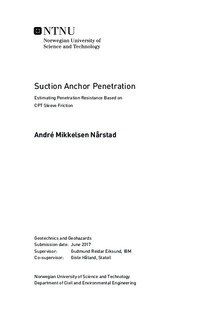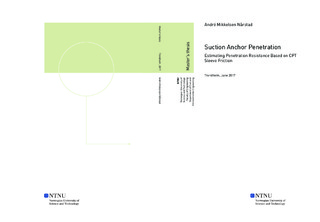| dc.description.abstract | Oil and gas are number one commodity when it comes to transportation and energy, and with increasing worldwide demand for oil the need to utilise deeper offshore oilfield are of the essence. Great depths present challenges not only technologically but also economically. With the stagnating oil prices from the last quarter of 2014 forces the oil industry to find the best economical solutions. One economical solution is the use of suction anchors to hold floating structures in place, this method also solves the problem with producing oil in ultra-deep waters.
This thesis has been looking at recommended methods to estimate suction needed to install suction anchors at the depth which gives suitable bearing capacity. Necessary suction has also been estimated with a new proposed method, a method utilising measured sleeve friction from cone penetration test. For a method to be useful it should estimate suction as close to the real suction measured, and yet be simple enough to keep investigation cost low.
All the methods utilised shows that remoulded shear strength plays a crucial role in estimating suction. The methods are based on two soil investigations techniques; values from laboratory test and cone penetration test measurement.
The new proposed method indicates that using sleeve friction directly (not corrected for pore pressure) for Gjøa field gives estimations twice as high as what measured. When sleeve friction is reduced to fit the measured suction, it is found that a fixed value with layer and depth shows promising results. The reduction of sleeve friction shows potential correlation with liquidity index.
The main conclusion from this thesis is that estimating suction for suction anchors can't be conducted solely based on cone penetration test measurement, and laboratory test must be conducted. With more research, this method could possible reduce the amount of costly laboratory test due to the use of index test. | |

